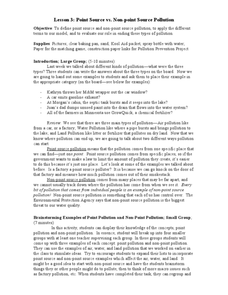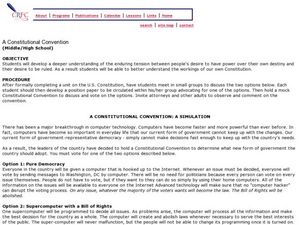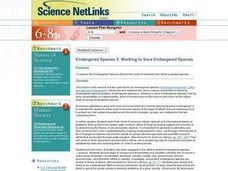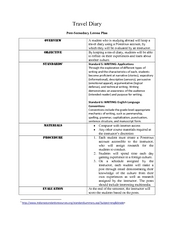Curated OER
The Need for Laws
Students consider the presence of authority in their lives. In this law lesson plan, students compare forgotten laws that function in their lives to forgotten instructions in making a peanut butter and jelly sandwich.
Curated OER
Philanthropy and You
Students identify human rights and study the values of historical figures who fought for human rights. In this human rights lesson plan, students define the term human rights and research examples of human mistreatment in history....
Curated OER
Democracy Then and Now
Students research more about the Canadian parliamentary democratic system.
Curated OER
How Did That Get There?
Students evaluate the role of government in addressing land use and other environmental issues. They analyze the powers, responsibilities, and limitations of elected and appointed officials in the national legislative, executive, and...
Curated OER
Children's Literature
Introduce the students to basic economic concepts and types of economic systems and develop the an understanding of how economic choices involve costs and consequences; provide introduction to rural America circa 1920 and compare to our...
Curated OER
Ancient Highways-Native Byways of Salmon Lake State Park
Eighth graders investigate the concept of the trail system used by the Native Americans. They compare and contrast the trails to modern transportation roadways of today. Students also define the types of information archaeologists use to...
Curated OER
Explora-Pond: 1st Grade Shore Count
First graders experience addition through the exploration of a virtual pond. They categorize the various plants around the pond, count the number of various types of plants on the pond shore, and calculate the number of shrubs.
Curated OER
Point Source vs. Non-point Source Pollution
Students define and differentiate between point source and non-point source pollution. Students discuss various types of pollution including air, water and land pollution, analyze demonstrations and complete a worksheet.
Curated OER
What It Is, What It Isn't
Third graders classify and sort different types of beans to be introduced to the classification system in science. As a class, they identify the characteristics of living and non-living organisms and make a chart in their journal to ...
Curated OER
What does it mean to be a citizen?
Students examine democracy and the role of a citizen. They contrast rights and responsibilities of individuals, groups, and organizations. Students identify two forms of democratic action and describe demoncratic values. Students observe...
Curated OER
A CONSTITUTIONAL CONVENTION: A SIMULATION
Students discuss two computerized options to change the current U.S. government. In this Constitutional Convention lesson, students write a statement advocating for one of the choices and participate in a mock modern Constitutional...
Curated OER
Eating a Nutritious Lunch
Students identify the types of foods and snacks they eat for their lunch. In groups, they identify healthy foods along with unhealthy foods. They design a new lunch menu using only healthy food and identifying which food group they belong.
Curated OER
The Fed is Protecting Your Money
Young scholars are introduced to the role of the Federal Reserve. In groups, they discover the three functions of money and discuss the most common forms of payment used in society today. They develop a survery to give to the local...
Curated OER
Endangered Species 2: Working to Save Endangered Species
Middle schoolers explore the Endangered Species Act and the work of scientists who strive to protect species.
Curated OER
Debate Topics and Ideas
Students examine both sides of arguments surrounding given debates. They use the internet and other research to collect information to support their stand on the controversial issue. Students debate their chosen topic. This lesson plans...
Curated OER
The Two Sides of the Declaration of Independence
Budding historians read six documents related to grievances that led to the writing of the Declaration of Independence. They then craft an essay in which they discuss the perspective of both the colonists and the king. This DBQ could be...
Curated OER
Missing Macroinvertebrates - Stream Side Science
Field study groups collect samples of stream water and identify the macroinvertebrates found. Using their data, they calculate a water quality index to rate the health of the stream. They graph their data and discuss the value of a water...
Curated OER
Video Game Violence: Explore Possible Impacts
Introduce middle schoolers to the issue of video game violence with a multifaceted approach. Learners complete a gaming survey, as well as read and discuss a news feature about violent video game sales and a handout on stimulus...
Curated OER
Travel Diary
Darwin kept a travel diary as he voyaged to South America, noting the politics, geography, cultures, animals, and interesting facts he encountered. Your class will do the same. Each student chooses a country to research and keep a five...
University of the Desert
What Is Extremism?
By participating in discussions using prompts and statements provided in the lesson plan plan, learners identify the concept of extremism and consider what causes violent acts of extremism in the modern...
Curated OER
Castles and Forts of Wales and Oregon
Pupils compare a castle in Wales to a fort in Oregon and design and build a castle or fort. In this structure study lesson, students complete activities to study castles in Wales to forts in England. Pupils then design their own fort or...
Curated OER
What is the Average Height of Your Class?
In this statistics lesson, learners use an on-line form generator create a class-specific form, then complete the form, view a graph and data analysis, and draw conclusions.
Pocumtuck Valley Memorial Association
A Research Project: A Discussion of the Recreating and Populating of a Colonial Village
Primary source research, secondary source readings, and discussion provide the understanding necessary for students to create a colonial persona, and simulate a situation appropriate for this person, time, and place. While the...
Curated OER
Sun Prints
Students discuss energy and where they can find it. They will then discuss the sun and how it functions as an energy source. Next, students get a piece of black paper and some coins. They go outside and make a design with the coins on...























